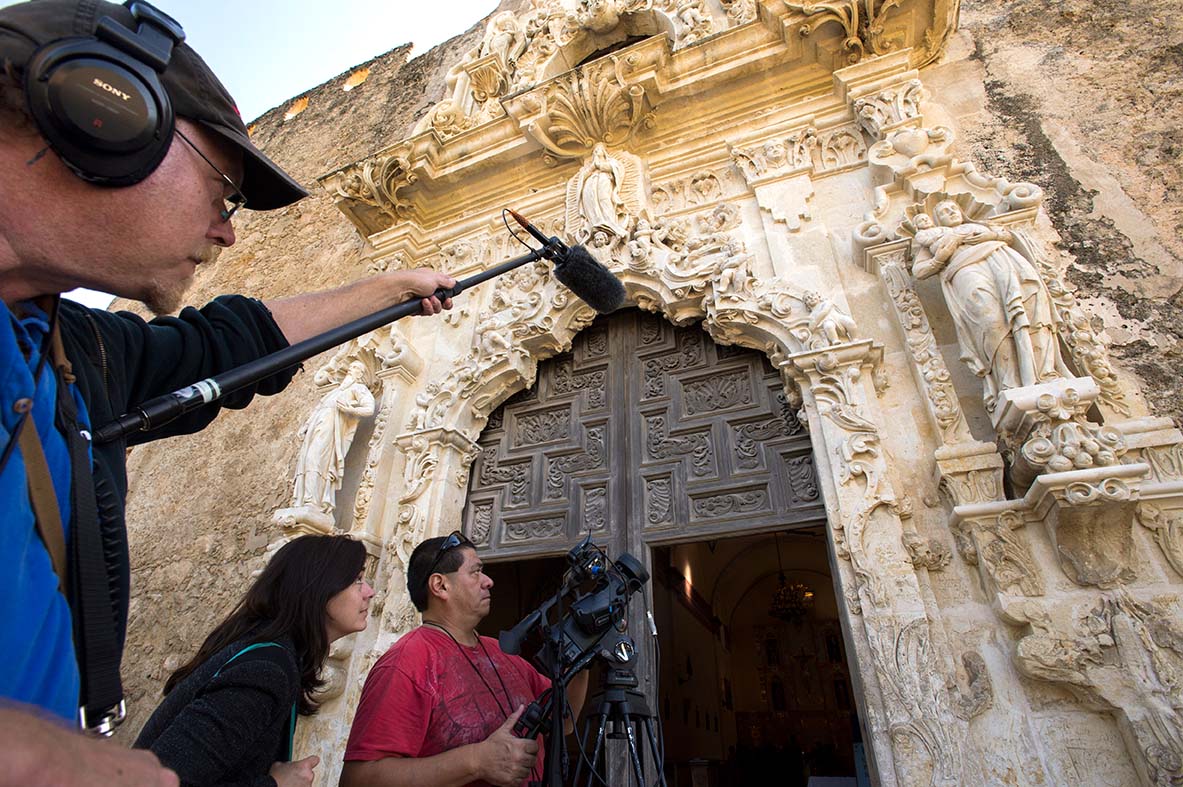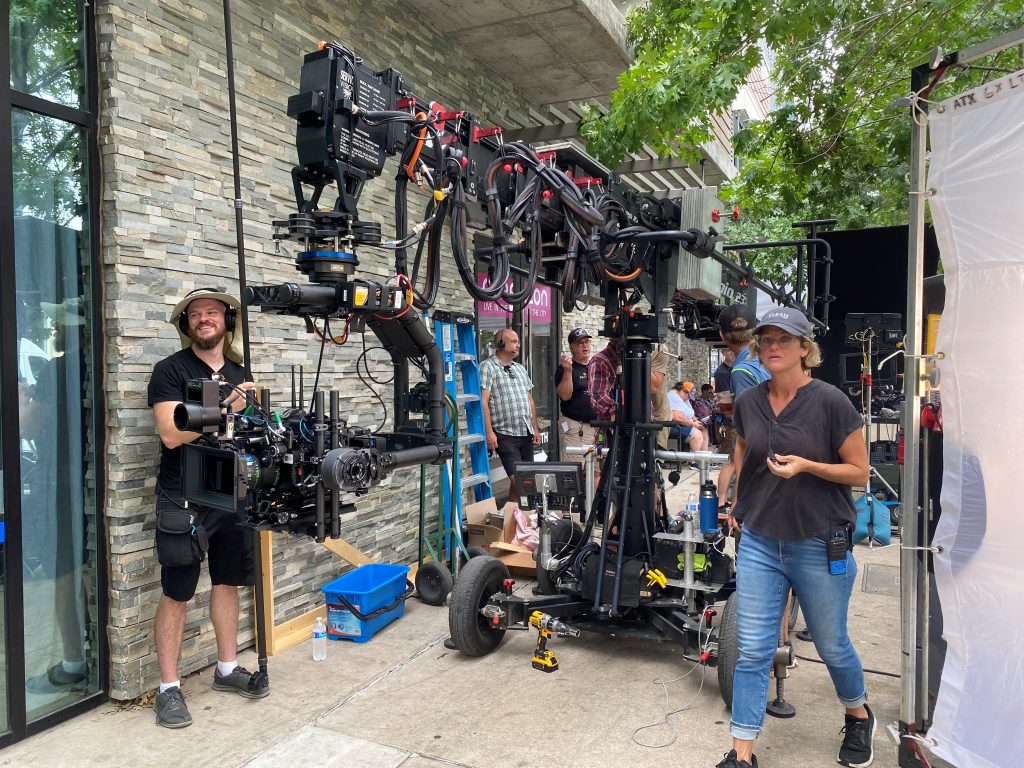
A documentary film crew at Mission San José y San Miguel de Aguayo in San Antonio. Photo by Michael Amador
When Will Mederski moved to Austin from Ohio in 2015, he was enjoying the climate and culture, working mostly as a freelance photographer, and spending his days off munching breakfast tacos and hanging out at Barton Springs. One day at a friend’s house, a new neighbor stopped by to introduce himself. He was a film director, new in town, and asked if anyone would like to make some extra money working on a film set. The proposition seemed too good to be true, but within a few months Mederski found himself working as a lighting technician in a lucrative new industry.
“I could work three or four days a week and make a week’s worth of pay,” Mederski says. “It was a pretty easy option for work. The flexibility was definitely an attraction; I’ve never been one for the nine-to-five jobs.”
As in any other industry, Mederski had to work his way up. He started out logging long hours, lighting sets for music videos and PSAs as side gigs, then the occasional low-budget indie film would come his way. In 2017 he managed to get a regular job working as an electrician and lighting tech on the set of Fear the Walking Dead, one of the biggest productions in Austin at that time. By 2019, he was working full-time on the show. Then in 2021, production was shifted to Savannah, Georgia, to reap the benefits of that state’s incentive program. Georgia’s lawmakers have approved $1.3 billion in tax credits for filmmakers who opt to make movies and TV shows in the Peach State. When the production migrated to Savannah, the entire crew was left without steady work. Mederski’s story is the same as hundreds of other workers in the Texas film industry: They had found a good job and had worked hard, long hours to get ahead, just for the jobs to leave the state when incentives dried up.
To say the Texas film industry has been a roller coaster ride would be an understatement. Film incentives are financial benefits that encourage in-state film productions. The offerings vary by state and can range from movie production incentives, to cash rebates or grants, and even sales tax and lodging exemptions. In Texas, the incentive program is overseen by the Texas Film Commission, a state agency. Applicants must meet criteria such as 70 percent of the crew must be Texas residents and 60 percent of production days must be completed in the state. A lot of the aid goes to things like construction jobs to build sets which buy supplies from Texas businesses, lodging for workers who travel, and catering for entire crews multiple times a day means that money is spread around to dozens of local businesses.
In 2008, the state offered grants to offset 5 percent of filmmaking costs; the program had $22 million to allocate. By 2013 the program’s budget had increased to cover 20 percent of costs—its total allocations rose to $95 million over the biennium—in an effort to compete with the neighboring states of New Mexico, Louisiana, and even (cough) Oklahoma. But from 2015 to 2019, that number was slashed by two-thirds, to $32 million, making it more difficult to compete with other states. In contrast, in 2019 New Mexico took their incentives program from $50 million to $110 million and offered up to 30% refund per film and TV show. This is why you’ll sometimes see films set in Texas (e.g., Hell or High Water or Sicario: Day of the Soldado) with the Rocky Mountains or other non-Texas landscapes in the background.
Lawmakers in Texas and other states don’t always see eye to eye on how to implement film incentives, which could help explain the program’s volatility. For its part, the Texas Film Commission claims that subsidies have generated $1.95 billion in in-state spending and have created 183,000 jobs. Critics of film incentive programs, including elected officials and public policy analysts, have cast doubt on the effectiveness of such payouts here and elsewhere—taxpayer money spent on luring filmmakers could have gone to more deserving beneficiaries, such as teachers and first responders, they say.
When incentives left Texas, so did a lot of the workers. Makeup and hairstylist Mischa Fruge moved to Los Angeles in 2022 and says she knows several people who moved to California, Georgia, New Mexico and Pennsylvania. Those who remained in Texas were left to fight for the scraps. Mederski says these days, he gets as little as one day’s work a month. “There was maybe a show here and there going on,” says Audra Hughes, a utility sound technician and boom mic operator. “There were shows happening all over the place, then come December or January, the $32 million incentive had dried up and all the productions fizzled.”

A film crew prepares a shot on set. Photo courtesy of Alex Fedolak
The Texas film industry was given new hope in this year’s legislative session, due in part to a campaign launched by Denis Quaid and Jeremy John Wells and Lt. Governor Dan Patrick’s appreciation for the work of Taylor Sheridan. Lawmakers passed a historic $200 million incentive package for the next biennium, more than double the previous high point reached in 2013. But Texas film workers will tell you; the incentives are not just to help them. “It’s a good start,” says Production Supervisor Alex Fedolak. “We’ve got a really good group of crew members here. There are very talented people in this state. It’s [also] great for the state because it brings so much more money in and employs so many more people.”
While the uptick in tax credits is good news, strikes implemented by national writers’ and actors’ unions this year have dampened the mood somewhat. The strikes stand to keep major productions from coming to the state for the moment, but Texas film workers know full well what’s on the line, and they’re ready to do their part to make sure future generations of workers get a fair deal. “Texas has seen slow times before, and we’re used to making things work,” says Mederski. “But Texans can weather a drought better than any.”








